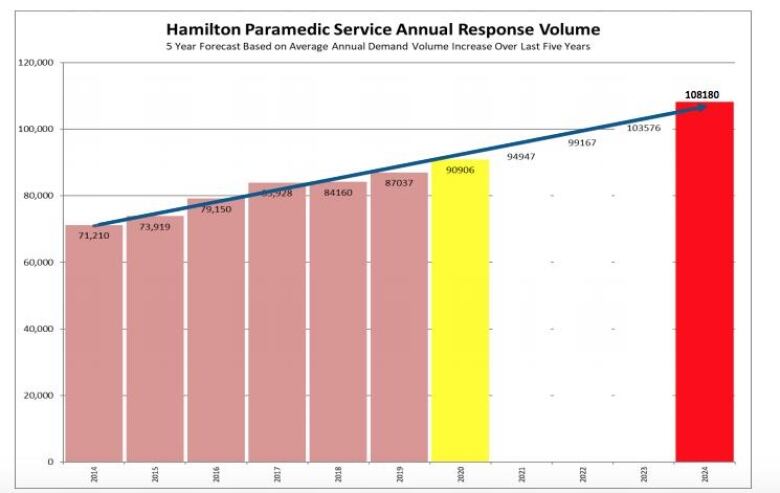Paramedics left waiting to unload patients at hospitals cost Hamilton $6M a year
Hospitals are crowded, says the paramedic chief, so they take longer to admit patients

Hamilton hospitals are so crowded that it's taking hours for paramedics to offload patients at their doors. That timeleft waiting is adding up and cost the city more than $6 million last year.
Mike Sanderson, chief of Hamilton Paramedic Service, says overcrowding at hospitals result in wait times of up to five hours for patients in ambulances, and paramedics have to wait with them. That accounted for 30,549 hours of paramedic time last year, he said, and that number has been rising year after year. In 2018, it was 27,512 hours.
"That's time that could be spent back on the roads," said Sandersonafter a budget presentation Thursday.
Offload times, and availability of ambulances, have been an issue in Hamilton for years.Last year, the city had 80 code zero events, a term usedwhen there are no ambulances available to answer calls. Offload times are a big factor in that.
Code zeros may have decreased in 2019 compared to96 the year before, but that's because the city put six new ambulances on the road overthe last six years, Sanderson said. Actual offload times are getting worse. Hamilton Paramedic Service has even implemented a program it calls "Fit-to-Sit," where paramedics place patients who need less urgent care in the waiting room so they can leave again.
Sanderson said no one is keeping track of the impact delays are having on the health of patients, but people have had heart attacks while they wait. Offload delays usually happen with patients whose problems aren't acute, such as abdominal pains, difficulty breathing or COPD, he said.

But "patients lying on an ambulance stretcher for three,fourand fivehours is neither comfortable nor appropriate," he said. "There's a whole variety of issues in terms of patient dignity and patient comfort."
Hospitals are working with the paramedic service to try to speed up wait times, said Mayor Fred Eisenberger. But they're limited in what they can do too.
Hamilton Health Sciences (HHS)said this month that it has about 100 unfunded beds on any given day, some of which are in hallways and sun rooms. Data obtained by a CBC News Freedom of Information Act request shows that Hamilton General Hospitalranks fourth among Ontario hospitals for being most frequently filled beyond capacity.
"Wehave on average about 30 patients or 35 patients a day that are not in a conventional bed," said Wes Stephen, HHS chief operating officer said at the time. "I think most of us would suggest it's not a situation that we would want for ourselves or our family."
Paramedic calls have been increasing overall. Last year, paramedics answered 87,037 calls, about 3,000 more than they did the year before.
For eight per cent of the calls last year, Sanderson said, there were between zero and four ambulances free for new calls.
Overall, the draft operating budget for the paramedic service showed a 9.9 per cent increase, or $26,148,270. In 2019, the city spent $23,794,770.
The budget for the healthy and safe communities department which also includes Ontario Works, fire services, housing, long-term care and public health has a draft increase of 2.7 per cent.












_(720p).jpg)


 OFFICIAL HD MUSIC VIDEO.jpg)
.jpg)



























































































